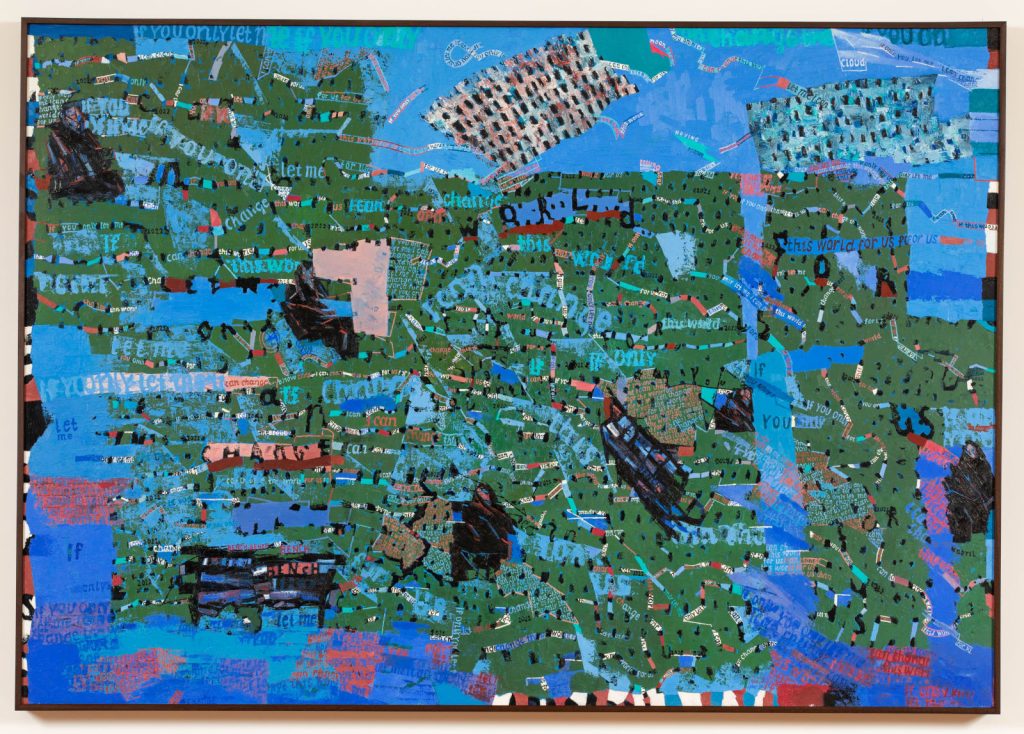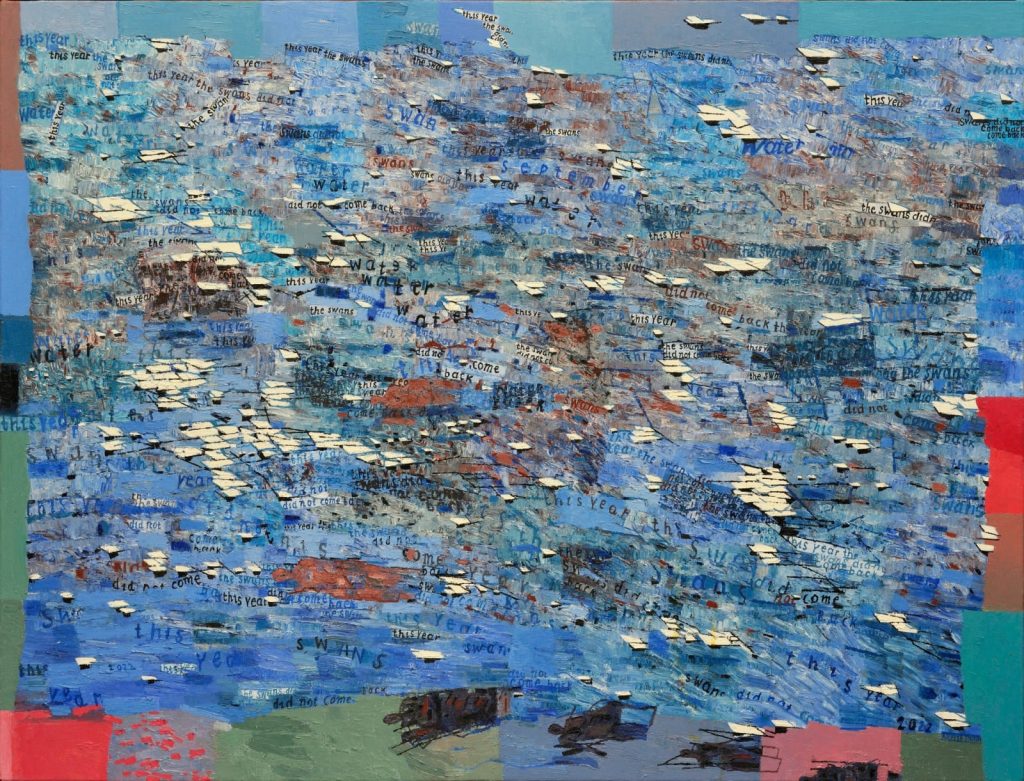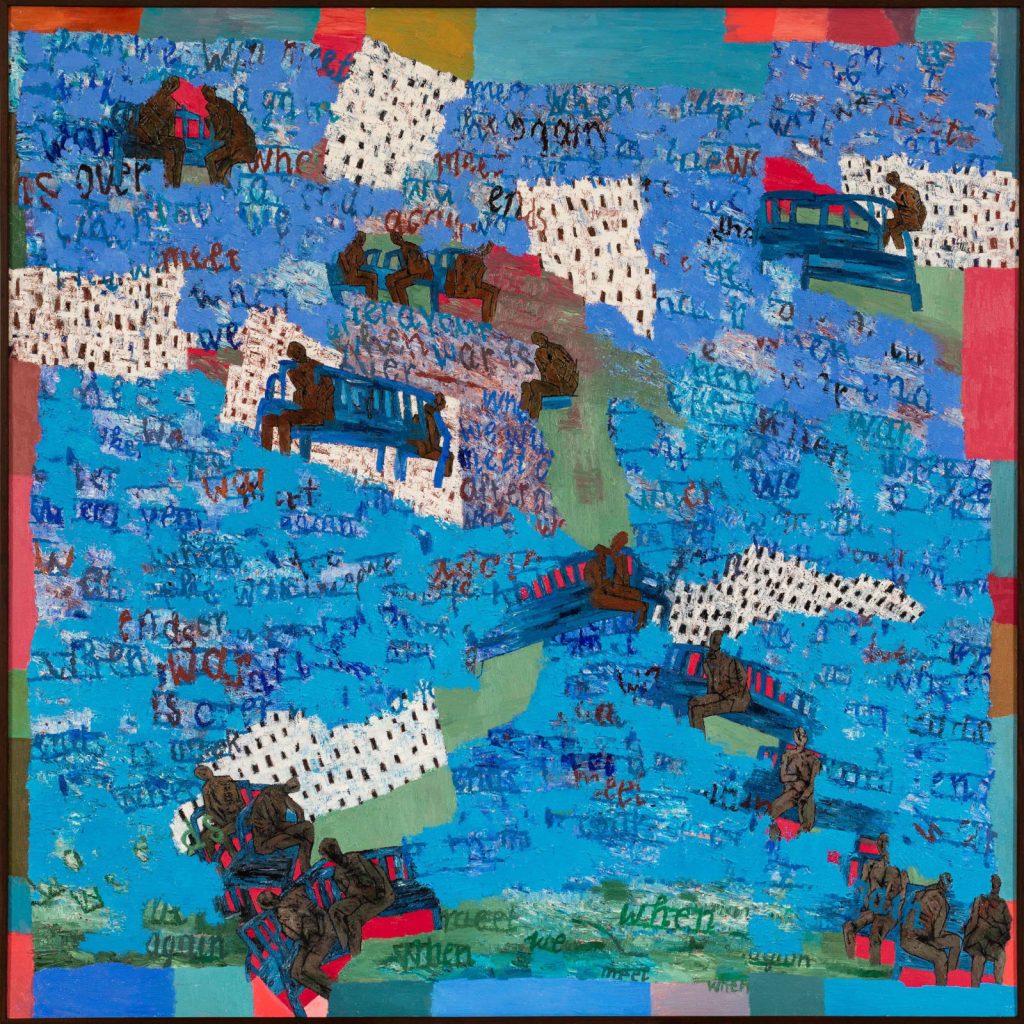Ved Prakash Bhardwaj

Amidst the divergence of social and political systems, Arpita Singh’s painting has been a specialty by keeping the psychology of man at the center. From the very beginning, there has been a sense of irony in her art. Functioning like a scathing commentary, her paintings and drawings expose the realities of our times. Her 2023 solo exhibition at Vadehra Art Gallery, Delhi marks a departure from her usual point of expression.
Human figures predominate in her drawings, but there is a shift as words have taken the place of human figures in her paintings. She has been using words and lines in her earlier paintings as well, but this time they appear in a more intense manner. She has no clear reason as to why this shift has manifested. When I talked to her about this, she said that perhaps it is the effect of the books she has read in recent days. Her consistent reading habits are perhaps the reason why her paintings often appear like a story. Structural abstraction is dominant in her paintings this time. She does not create the shapes in the paintings in a realistic manner. With the absence of shapes in the paintings that have been included in this exhibition, abstraction appears to be more powerful.
Arpita Singh’s paintings sometimes look like a stage on which a still scene of a play is displayed. This scene looks like it has been frozen in time. Whatever appears to happen in this stagnant time indicates the dynamism of life. Arpita Singh expresses the contradictory situations in this social mobility in a symbolic form. Sad women sitting in the park, some tired men, people returning from work, some flowers in bloom, etc. make this theater mysterious. There is so much happening in this picture of frozen time that just needs to be understood.

The empty space on the stage, whether after or before the end of the play, has its own significance and role. Because there is less human presence in these paintings, the empty space becomes more prominent. This void begs the question of human existence. The entire painting appears to be an arrangement in which human intervention has been greatly reduced. This is the new face of our times. The role of man in technology and the systems it operates is being questioned. Arpita Singh’s new paintings indicate this direction. There is also a hint that the empty space where no activity is visible at the moment should make the viewer think about what has happened and what is about to happen.
Arpita Singh was born in a Bengali family in 1937 in West Bengal. Later she came to Delhi where she studied arts at Delhi Polytechnic. The Delhi Polytechnic later became the Delhi School of Art. Here she met Paramjit Singh, who became her life partner after a long courtship. After completing her art education in 1959, she joined the Government of India in the Cottage Industries Restoration Program where she met traditional artists and weavers.
Arpita Singh’s earlier works used to have clear human figures which have become abstract this time. One of the reasons behind this is probably that personal identity or a clear identity has become difficult today. That’s why Arpita created the piece in an abstract style. However, in some of the paintings in this exhibition, the figures of men and women can be identified.
A painting depicts men sitting together on benches in a park, conversing with each other. This is a common sight that can be seen in any park. But the kind of composition it has given it a whole new meaning. Some persons are alone while some are sitting opposite each other. It expresses the growing tension between the dialogues in society. Arpita often expresses social situations through such compositions.
Arpita’s artistic journey began with abstract landscapes, which also influenced paintings that express the human condition. Most of her paintings depict humans in a landscape that includes both natural and man-made landscapes. She has created the metropolitan structures in an abstract form and has used green and blue surfaces to represent the natural condition. Between these and with some words and phrases, she takes forward her point. We can see this in the paintings included in this exhibition.
The title of this exhibition has been given as meeting. That is why the paintings displayed in it show people meeting and talking, including both men and women. Many of these pictures are from the time of the Corona crisis when social gatherings had almost stopped.

In these paintings, as in the past, Arpita does not drop too many hints for the viewer. In her earlier works, we have seen how she used to create clear human figures with other auxiliary figures, like airplanes, motorcycles, cars, flower pots, and many such things which give context to the whole painting. These references are few in this exhibition. We can say that now in a way she has reduced the speaking in his painting and left an open sky of imagination for the viewer.
The increasing abstraction of human figures and the reduction of objects on the canvas suggest a move towards saying more with fewer symbols. Earlier her paintings featured more human movement, almost like some maddened crowd which has now subsided. At times her canvas appears like an empty stage on which silence overwhelms after the play is over. Even though that silence is telling, it also hints at what happened as well as what could happen. Arpita Singh creates this sign in her way.





